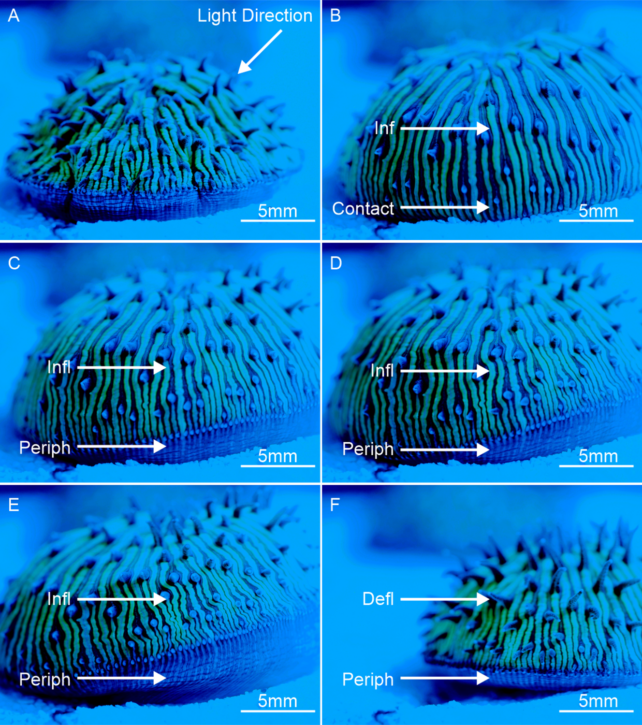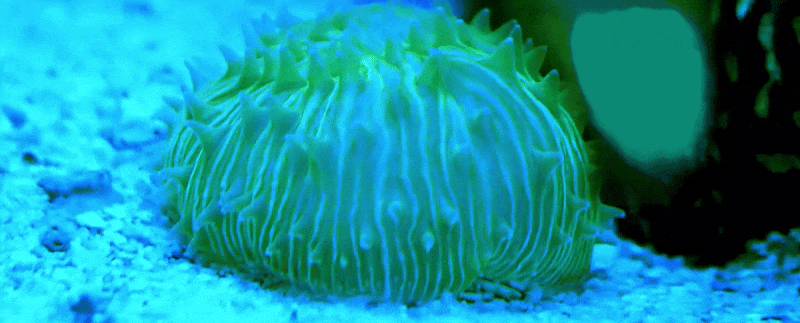When you imagine a coral, it's probably not walking around. In fact, by most accounts, corals are sessile, meaning they are fixed to the surface of their habitat, often the reef built from the bones of their ancestors.
But a few maverick corals have shunned this home-bound lifestyle. Among them, a tiny mushroom coral named Cycloseris cyclolites has found a way to propel itself across sandy sea floors to quite literally chase the sun.
A team led by cnidariologist Brett Lewis, from the University of Queensland, used time-lapse videos to watch the corals scoot across their tanks using a strategy similar to jellyfish, coral's untethered cousins.
On a human timescale, this is a painfully slow way of getting around: One coral budged just 43.73 millimeters over the course of 24 hours.
In the first hour or so, Lewis watched the coral swell up as its outermost tissues inflated, which allowed the center of the coral to be lifted up from the seafloor.
"I watched this thing for a very long time, thinking it was going to pop," Lewis told Jason Bittel at the New York Times. "I was like, 'Christ almighty, this is taking a long time to happen'."
Then, when the inflated tissue contracted, contact with the surface was transferred to a kind of 'foot' structure underneath the coral, which enabled it to inch forward.
These movements were coordinated toward a certain light source via contraction and twisting of the outer tissue, "which propelled the coral forward in a coordinated manner resembling the pulsed swimming motion of jellyfish," the researchers write in a new study.
This must be an exhausting task for a coral colony, but worthwhile when you consider that gravity, waves, currents and even other creatures can easily move these corals to less-than-ideal locations.
Most corals rely on a symbiosis with the dinoflagellates embedded in their tissues. These single-celled organisms produce energy from sunlight, which is then harvested by the coral. Location – and the light that reaches it – is crucial.
For a free-living coral like Cycloseris cyclolites, being able to climb out of a shady ditch, however long it takes, may be the difference between life or death.

"Our findings suggest that pulsed inflation is not just a survival strategy but a critical mechanism for migration and navigation," Lewis says.
"The ability of Cycloseris cyclolites to move towards specific light sources is a fascinating parallel to other marine species like jellyfish, which suggests they are more neurologically sophisticated than previously thought."
To see the corals in action, their tanks were shrouded in near-darkness, with a lure of either white or blue light shining at one end.
The corals seem motivated mainly by blue light, with 86.7 percent of corals seeking it out, compared with only 13.3 percent when the white light was offered. When both blue and white light were offered, one at each end of the aquarium, all three corals involved in that experiment chose blue.
The narrow blue light sources (~420 nm and ~510 nm) are akin to the coral species' habitat of deeper water sand beds, where light waves above roughly 480 nm cannot reach. White light, with its breadth of wavelengths, is more similar to shallower surface waters.
Shallow water temperatures can be harmful to the coral's dinoflagellate farm, as we see with coral bleaching, which may explain why the corals avoid white-lit waters.
"The findings also have important ecological implications," Lewis says.
"Understanding their movement strategies could help scientists predict how migratory corals might resist, survive or adapt to changes in environmental conditions such as sea surface changes caused by climate change, which can be reduced by the deeper waters these corals migrate to.
"With these climate-driven factors increasing, the faster the migration, the higher the chance of survival."
The research was published in PLOS One.
